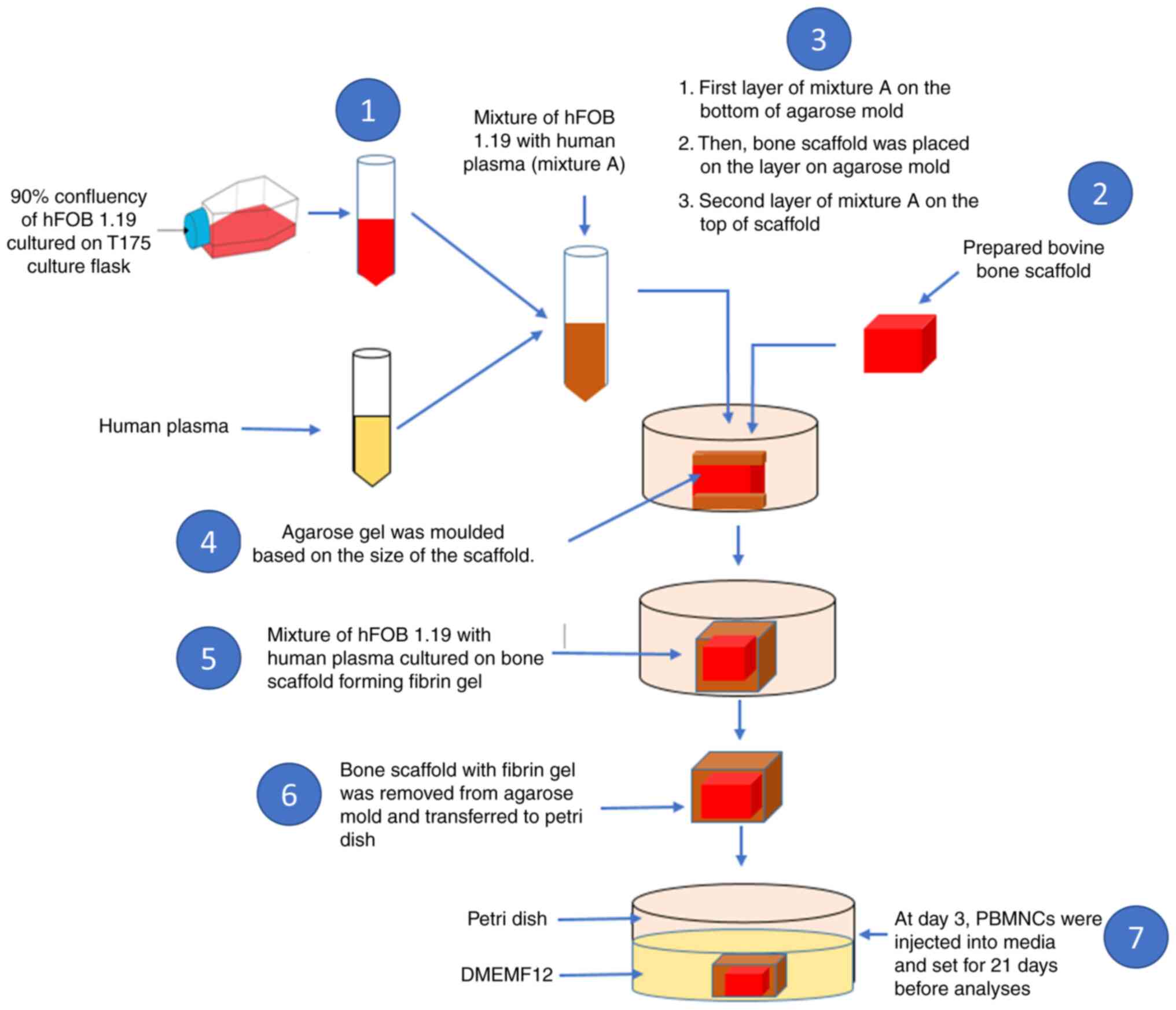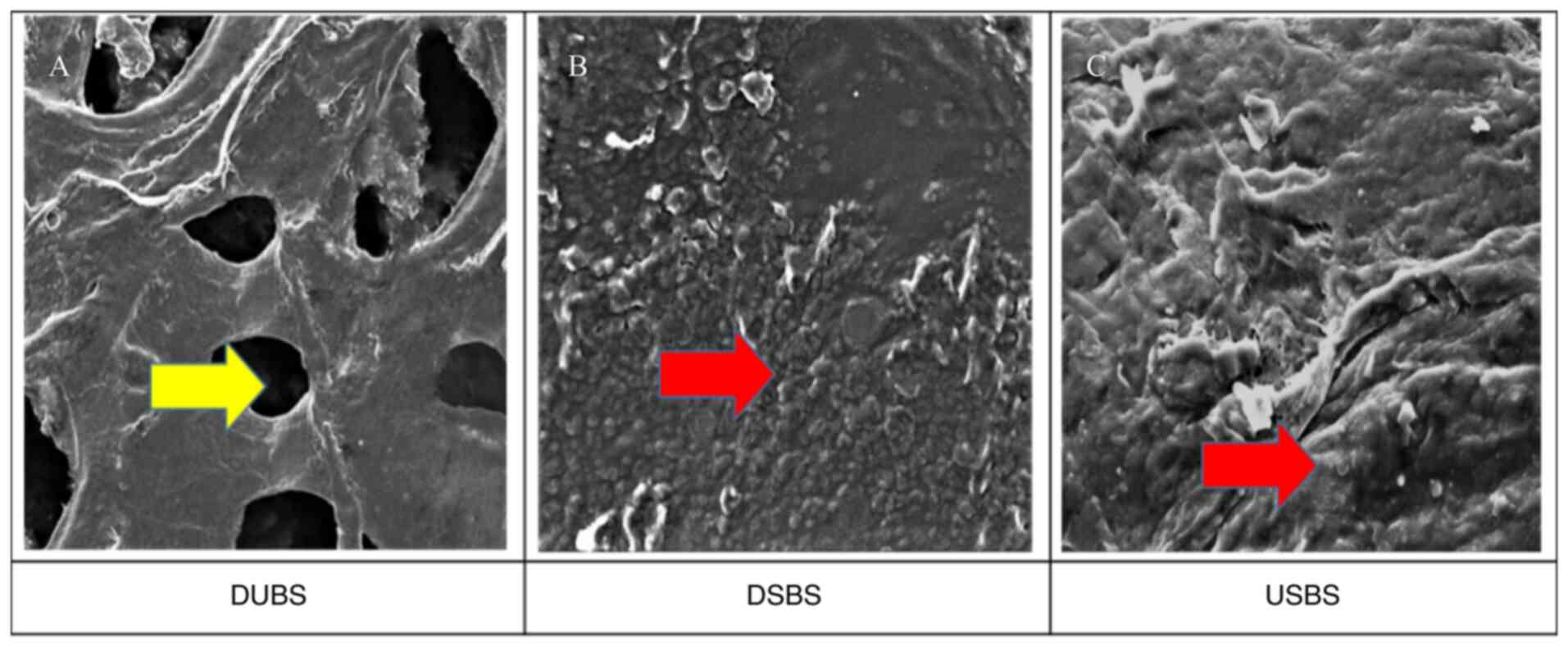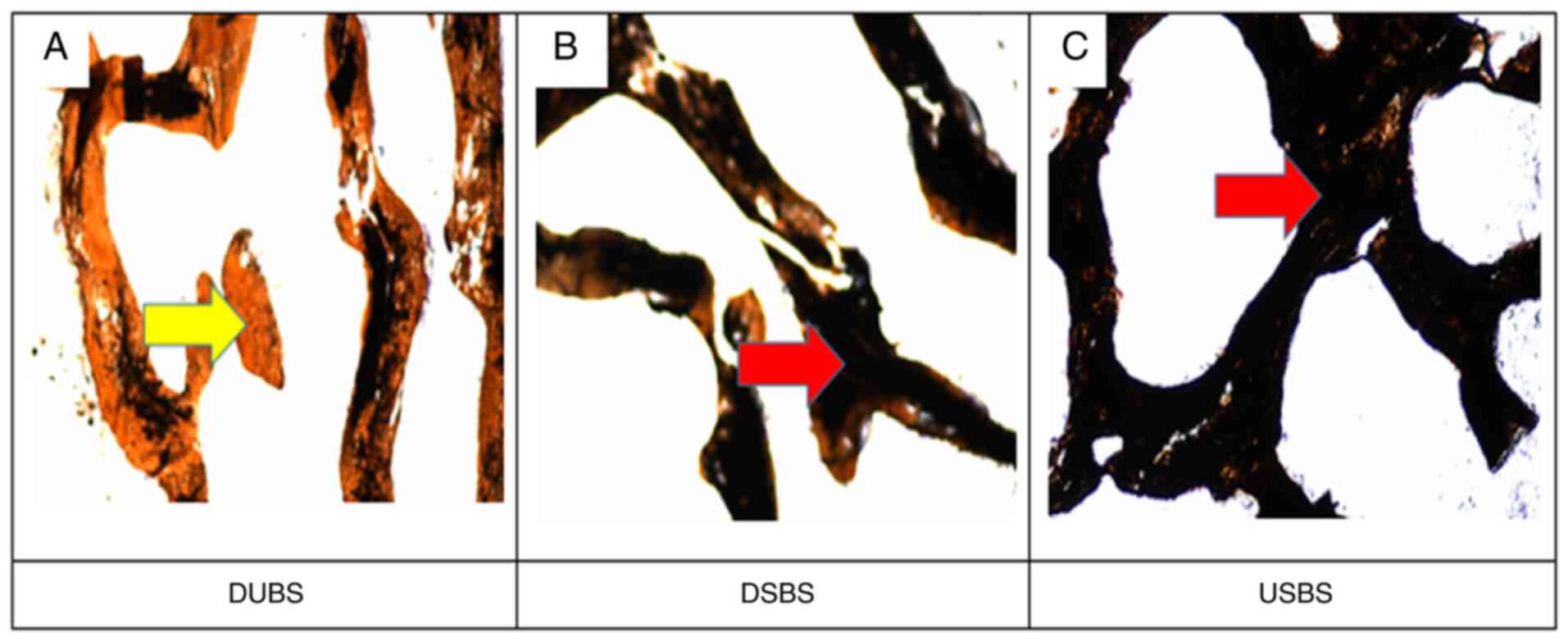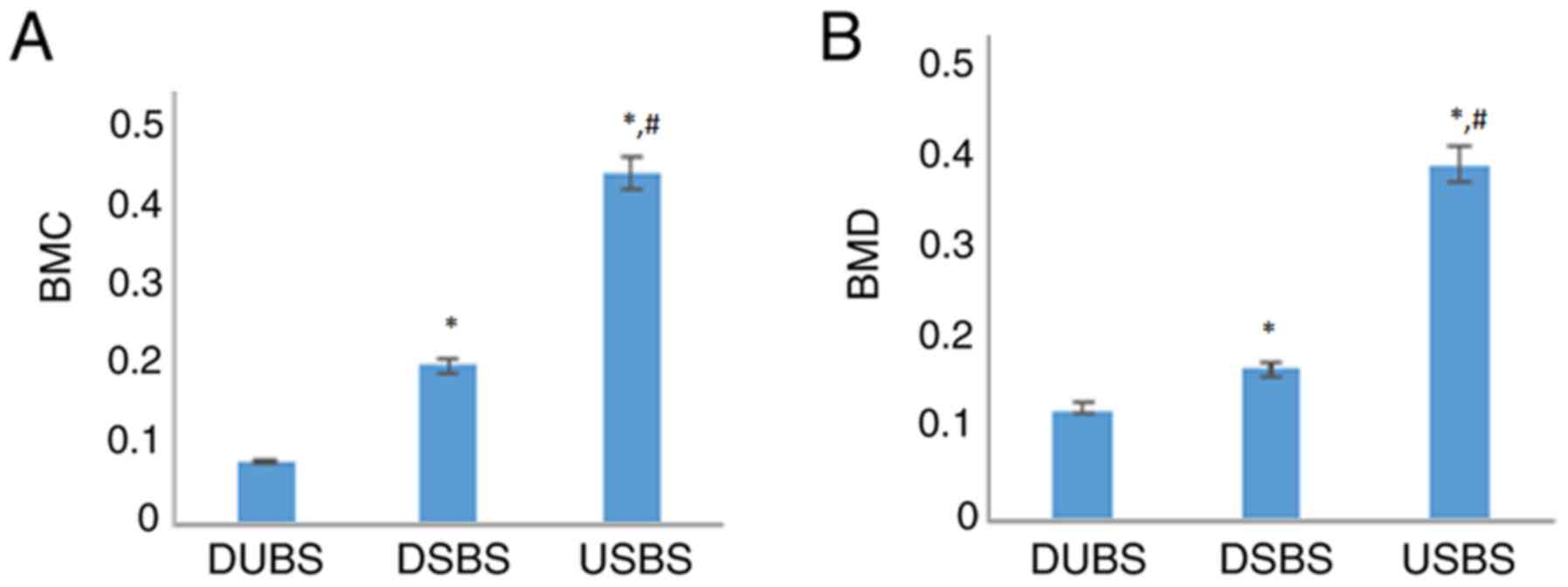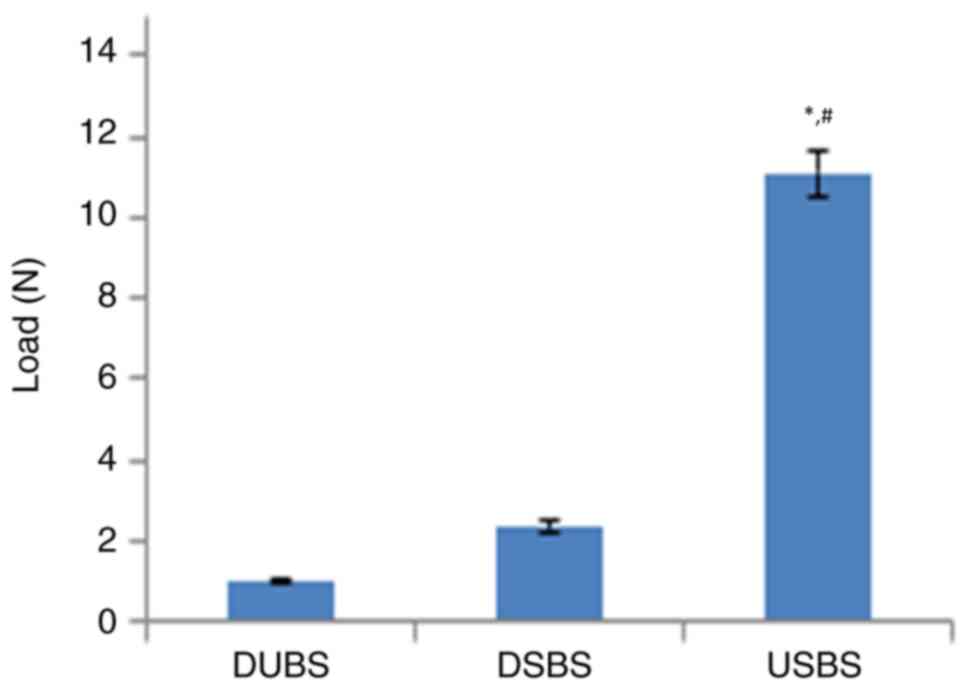|
1
|
Zahedi E, Ansari S, Wu BM, Bencharit S and
Moshaverinia A: Hydrogels in craniofacial tissue engineering. In:
Biomaterials for Oral and Dental Tissue Engineering. Elsevier,
pp47-64, 2018.
|
|
2
|
Jin H-H, Kim D-H, Kim T-W, Shin KK, Jung
JS, Park HC and Yoon SY: In vivo evaluation of porous
hydroxyapatite/chitosan-alginate composite scaffolds for bone
tissue engineering. Int J Biol Macromol. 51:1079–1085.
2012.PubMed/NCBI View Article : Google Scholar
|
|
3
|
Venkatesan J, Bhatnagar I, Manivasagan P,
Kang K-H and Kim S-K: Alginate composites for bone tissue
engineering: A review. Int J Biol Macromol. 72:269–281.
2015.PubMed/NCBI View Article : Google Scholar
|
|
4
|
Karageorgiou V and Kaplan D: Porosity of
3D biomaterial scaffolds and osteogenesis. Biomaterials.
26:5474–5491. 2005.PubMed/NCBI View Article : Google Scholar
|
|
5
|
LeGeros RZ: Properties of osteoconductive
biomaterials: Calcium phosphates. Clin Orthop Relat Res. 395:81–98.
2002.PubMed/NCBI View Article : Google Scholar
|
|
6
|
Wang H, Li Y, Zuo Y, Li J, Ma S and Cheng
L: Biocompatibility and osteogenesis of biomimetic
nano-hydroxyapatite/polyamide composite scaffolds for bone tissue
engineering. Biomaterials. 28:3338–3348. 2007.PubMed/NCBI View Article : Google Scholar
|
|
7
|
Huh J, Lee J, Kim W, Yeo M and Kim G:
Preparation and characterization of gelatin/α-TCP/SF biocomposite
scaffold for bone tissue regeneration. Int J Biol Macromol.
110:488–496. 2018.PubMed/NCBI View Article : Google Scholar
|
|
8
|
Murphy CM, Haugh MG and O'Brien FJ: The
effect of mean pore size on cell attachment, proliferation and
migration in collagen-glycosaminoglycan scaffolds for bone tissue
engineering. Biomaterials. 31:461–466. 2010.PubMed/NCBI View Article : Google Scholar
|
|
9
|
Vozzi G, Corallo C, Carta S, Fortina M,
Gattazzo F, Galletti M and Giordano N:
Collagen-gelatin-genipin-hydroxyapatite composite scaffolds
colonized by human primary osteoblasts are suitable for bone tissue
engineering applications: In vitro evidences. J Biomed Mater Res A.
102:1415–1421. 2014.PubMed/NCBI View Article : Google Scholar
|
|
10
|
Hofmann S, Hagenmüller H, Koch AM, Müller
R, Vunjak-Novakovic G, Kaplan DL, Merkle HP and Meinel L: Control
of in vitro tissue-engineered bone-like structures using human
mesenchymal stem cells and porous silk scaffolds. Biomaterials.
28:1152–1162. 2007.PubMed/NCBI View Article : Google Scholar
|
|
11
|
Nam YS, Yoon JJ and Park TG: A novel
fabrication method of macroporous biodegradable polymer scaffolds
using gas foaming salt as a porogen additive. J Biomed Mater Res.
53:1–7. 2000.PubMed/NCBI View Article : Google Scholar
|
|
12
|
Laurencin C, Lu H and Khan Y: Processing
of polymer scaffolds: Polymer-ceramic composite foams. Tissue Eng
Part C Methods. 705–714. 2002.PubMed/NCBI View Article : Google Scholar
|
|
13
|
Lloyd AW: Interfacial bioengineering to
enhance surface biocompatibility. Med Device Technol. 13:18–21.
2002.PubMed/NCBI
|
|
14
|
Velasco MA, Narváez-Tovar CA and
Garzón-Alvarado DA: Design, materials, and mechanobiology of
biodegradable scaffolds for bone tissue engineering. Biomed Res
Int. 2015(729076)2015.PubMed/NCBI View Article : Google Scholar
|
|
15
|
Ma PX and Zhang R: Microtubular
architecture of biodegradable polymer scaffolds. J Biomed Mater
Res. 56:469–477. 2001.PubMed/NCBI View Article : Google Scholar
|
|
16
|
Levenberg S, Huang NF, Lavik E, Rogers AB,
Itskovitz-Eldor J and Langer R: Differentiation of human embryonic
stem cells on three-dimensional polymer scaffolds. Proc Natl Acad
Sci USA. 100:12741–12746. 2003.PubMed/NCBI View Article : Google Scholar
|
|
17
|
Rezwan K, Chen QZ, Blaker JJ and
Boccaccini AR: Biodegradable and bioactive porous polymer/inorganic
composite scaffolds for bone tissue engineering. Biomaterials.
27:3413–3431. 2006.PubMed/NCBI View Article : Google Scholar
|
|
18
|
Guda T, Appleford M, Oh S and Ong JL: A
cellular perspective to bioceramic scaffolds for bone tissue
engineering: The state of the art. Curr Top Med Chem. 8:290–299.
2008.PubMed/NCBI View Article : Google Scholar
|
|
19
|
Pilliar RM, Filiaggi MJ, Wells JD, Grynpas
MD and Kandel RA: Porous calcium polyphosphate scaffolds for bone
substitute applications - in vitro characterization. Biomaterials.
22:963–972. 2001.PubMed/NCBI View Article : Google Scholar
|
|
20
|
Rodrigues CV, Serricella P, Linhares AB,
Guerdes RM, Borojevic R, Rossi MA, Duarte ME and Farina M:
Characterization of a bovine collagen-hydroxyapatite composite
scaffold for bone tissue engineering. Biomaterials. 24:4987–4997.
2003.PubMed/NCBI View Article : Google Scholar
|
|
21
|
Zhao H, Ma L, Gao C and Shen J:
Fabrication and properties of mineralized
collagen-chitosan/hydroxyapatite scaffolds. Polym Adv Technol.
19:1590–1596. 2008.
|
|
22
|
Schönmeyr BH, Wong AK, Li S, Gewalli F,
Cordiero PG and Mehrara BJ: Treatment of hydroxyapatite scaffolds
with fibronectin and fetal calf serum increases osteoblast adhesion
and proliferation in vitro. Plast Reconstr Surg. 121:751–762.
2008.PubMed/NCBI View Article : Google Scholar
|
|
23
|
Polo-Corrales L, Latorre-Esteves M and
Ramirez-Vick JE: Scaffold design for bone regeneration. J Nanosci
Nanotechnol. 14:15–56. 2014.PubMed/NCBI View Article : Google Scholar
|
|
24
|
Silva GAB, Bertassoli BM, Sousa CA,
Albergaria JD, de Paula RS and Jorge EC: Effects of strontium
ranelate treatment on osteoblasts cultivated onto scaffolds of
trabeculae bovine bone. J Bone Miner Metab. 36:73–86.
2018.PubMed/NCBI View Article : Google Scholar
|
|
25
|
Shahabipour F, Mahdavi-Shahri N, Matin MM,
Tavassoli A and Zebarjad SM: Scaffolds derived from cancellous
bovine bone support mesenchymal stem cells' maintenance and growth.
In Vitro Cell Dev Biol Anim. 49:440–448. 2013.PubMed/NCBI View Article : Google Scholar
|
|
26
|
Mastrangelo F, Quaresima R, Grilli A,
Tettamanti L, Vinci R, Sammartino G, Tetè S and Gherlone E: A
comparison of bovine bone and hydroxyapatite scaffolds during
initial bone regeneration: An in vitro evaluation. Implant Dent.
22:613–622. 2013.PubMed/NCBI View Article : Google Scholar
|
|
27
|
Seibel MJ: Bone metabolism. In:
Encyclopedic Reference of MolecularPharmacology. Springer, Berlin
Heidelberg, Berlin, Heidelberg, pp190-197, 2004.
|
|
28
|
Jolly JJ, Chin KY, Farhana MFN, Alias E,
Chua KH, Hasan WNW and Ima-Nirwana S: Optimization of the Static
Human Osteoblast/Osteoclast Co-culture System. Iran J Med Sci.
43:208–213. 2018.PubMed/NCBI
|
|
29
|
Sulaiman SB, Keong TK, Cheng CH, Saim AB
and Idrus RB: Tricalcium phosphate/hydroxyapatite (TCP-HA) bone
scaffold as potential candidate for the formation of tissue
engineered bone. Indian J Med Res. 137:1093–1101. 2013.PubMed/NCBI
|
|
30
|
Setzer B, Bächle M, Metzger MC and Kohal
RJ: The gene-expression and phenotypic response of hFOB 1.19
osteoblasts to surface-modified titanium and zirconia.
Biomaterials. 30:979–990. 2009.PubMed/NCBI View Article : Google Scholar
|
|
31
|
Majeed SA, Mohamed N and Soelaiman I-N:
Quantification of Bone Histomorphometric Parameters Using the
Weibel Technique in Animals. Med Health. 11:278–288. 2016.
|
|
32
|
Siddiqui JA and Partridge NC:
Physiological bone remodeling: Systemic regulation and growth
factor involvement. Physiology (Bethesda). 31:233–245.
2016.PubMed/NCBI View Article : Google Scholar
|
|
33
|
Thomson RC, Yaszemski MJ, Powers JM and
Mikos AG: Fabrication of biodegradable polymer scaffolds to
engineer trabecular bone. J Biomater Sci Polym Ed. 7:23–38.
1995.PubMed/NCBI View Article : Google Scholar
|
|
34
|
Salgado AJ, Coutinho OP and Reis RL: Bone
tissue engineering: State of the art and future trends. Macromol
Biosci. 4:743–765. 2004.PubMed/NCBI View Article : Google Scholar
|
|
35
|
Rashmi RP, Pathak R, Amarpal Aithal HP,
Kinjavdekar P, Pawde AM, Tiwari AK, Sangeetha P, Tamilmahan P and
Manzoor AB: Evaluation of tissue-engineered bone constructs using
rabbit fetal osteoblasts on acellular bovine cancellous bone
matrix. Vet World. 10:163–169. 2017.PubMed/NCBI View Article : Google Scholar
|
|
36
|
Li Z, Ramay HR, Hauch KD, Xiao D and Zhang
M: Chitosan-alginate hybrid scaffolds for bone tissue engineering.
Biomaterials. 26:3919–3928. 2005.PubMed/NCBI View Article : Google Scholar
|
|
37
|
Sladkova M, Cheng J, Palmer M, Chen S, Lin
C, Xia W, Yu YE, Zhou B, Engqvist H and de Peppo GM: Comparison of
decellularized cow and human bone for engineering bone grafts with
human induced pluripotent stem cells. Tissue Eng Part A.
25:288–301. 2019.PubMed/NCBI View Article : Google Scholar
|
|
38
|
Huang R-L, Tremp M, Ho C-K, Sun Y, Liu K
and Li Q: Prefabrication of a functional bone graft with a pedicled
periosteal flap as an in vivo bioreactor. Sci Rep.
7(18038)2017.PubMed/NCBI View Article : Google Scholar
|
|
39
|
Andric T, Taylor BL, Whittington AR and
Freeman JW: Fabrication and Characterization of Three-Dimensional
Electrospun Scaffolds for Bone Tissue Engineering. Regen Eng Transl
Med. 1:32–41. 2015.
|
|
40
|
Liu X, Smith LA, Hu J and Ma PX:
Biomimetic nanofibrous gelatin/apatite composite scaffolds for bone
tissue engineering. Biomaterials. 30:2252–2258. 2009.PubMed/NCBI View Article : Google Scholar
|
|
41
|
Porter BD, Oldham JB, He SL, Zobitz ME,
Payne RG, An KN, Currier BL, Mikos AG and Yaszemski MJ: Mechanical
properties of a biodegradable bone regeneration scaffold. J Biomech
Eng. 122:286–288. 2000.PubMed/NCBI View
Article : Google Scholar
|
|
42
|
Chu T-MG, Orton DG, Hollister SJ, Feinberg
SE and Halloran JW: Mechanical and in vivo performance of
hydroxyapatite implants with controlled architectures.
Biomaterials. 23:1283–1293. 2002.PubMed/NCBI View Article : Google Scholar
|
|
43
|
Hutmacher DW: Scaffolds in tissue
engineering bone and cartilage. In: The Biomaterials. Silver
Jubilee Compendium Elsevier, pp175-189, 2006.
|
|
44
|
Ma PX: Scaffolds for tissue fabrication.
Mater Today. 7:30–40. 2004.
|
|
45
|
Gaspar DA, Gomide V and Monteiro FJ: The
role of perfusion bioreactors in bone tissue engineering.
Biomatter. 2:167–175. 2012.PubMed/NCBI View Article : Google Scholar
|
|
46
|
Ima Soelaiman S, Chua KH, Alias E, Chin
KY, Jolly JJ and Mohd Fozi NF: A Method Of Preparing A
Cell-Scaffold Composite For In-Vitro Study Of Therapeutic Agents On
Bone Disorders (Filing ID by Universiti Kebangsaan Malaysia:
PI2018701031).
|















